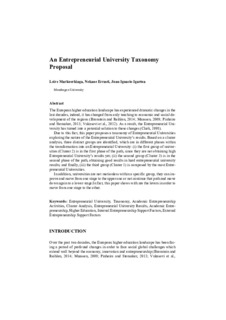Title
An Entrepreneurial University Taxonomy ProposalVersion
Postprint
Rights
© Springer Nature Singapore Pte Ltd.Access
Embargoed accessPublisher’s version
https://doi.org/10.1007/978-981-13-8130-0Published at
Developing Engaged and Entrepreneurial Universities. Theories, Concepts and Empirical Finding Thorsten Kliewe, Tobias Kesting, Carolin Plewa, Thomas Baaken (editores). Singapur: Springer Nature Singapore Pte Ltd., 2019Publisher
Springer Nature Singapore Pte Ltd.Keywords
Entrepreneurial University
Taxonomy
Academic Entrepreneurship Activities
Cluster Analysis ... [+]
Taxonomy
Academic Entrepreneurship Activities
Cluster Analysis ... [+]
Entrepreneurial University
Taxonomy
Academic Entrepreneurship Activities
Cluster Analysis
Entrepreneurial University’s results
Academic Entrepreneurship
Higher Education
Internal Entrepreneurship Support Factors
External Entrepreneurship Support Factors [-]
Taxonomy
Academic Entrepreneurship Activities
Cluster Analysis
Entrepreneurial University’s results
Academic Entrepreneurship
Higher Education
Internal Entrepreneurship Support Factors
External Entrepreneurship Support Factors [-]
Abstract
The European higher education landscape has experienced dramatic changes in the last decades, indeed, it has changed from only teaching to economic and social development of the regions (Bronstein an ... [+]
The European higher education landscape has experienced dramatic changes in the last decades, indeed, it has changed from only teaching to economic and social development of the regions (Bronstein and Reihlen, 2014; Maassen, 2009; Pinheiro and Stensaker, 2013; Vukasovi et al., 2012). As a result, the Entrepreneurial University has turned into a potential solution to these changes (Clark, 1998).
Due to this fact, this paper proposes a taxonomy of Entrepreneurial Universities exploring the nature of the Entrepreneurial University’s results. Based on a cluster analysis, three distinct groups are identified, which are in different phases within the transformation into an Entrepreneurial University: (i) the first group of universities (Cluster 2) is in the first phase of the path, since they are not obtaining high Entrepreneurial University’s results yet; (ii) the second group (Cluster 3) is in the second phase of the path, obtaining good results in hard entrepreneurial university results; and finally, (iii) the third group (Cluster 1) is composed by the most Entrepreneurial Universities.
In addition, universities are not motionless within a specific group, they can improve and move from one stage to the upper one or not continue that path and move down again to a lower stage. In fact, this paper shows with are the levers in order to move from one stage to the other. [-]





















